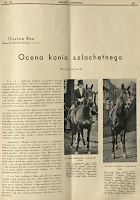Salvete Omnes,
[in Polish]
dzisiaj głos słynnego hipologa w temacie konika polskiego z lat 1930, zanim polska hodowle koni zniszczyli Niemcy i Sowieci.
Przypomnijmy dr Edward Skorkowskiego (1899-1985), hipolog i specjalista hodowli koni arabskich, sekretarz Towarzystwa Hodowli Konia Arabskiego w Polsce,
autor wielu publikacji naukowych i hodowlanych,a wiekopomne są '
Tablice Genealogicznych Polskich Koni Arabskich Czystej Krwi (1938, wydanie drugie w 1960 roku), czy wydana w 1927 roku praca '
Kon arabski w Polsce - rys historyczno-biometryczny'. (przypomnijmy, ze po 19121 roku stan polskiej hodowli koni był opłakany, a hodowli konia arabskiego wprost tragiczny, bo 90 % stad zostało zniszczonych działaniami wojennymi i rabunkiem - zniknęły stada w Sławucie, Jezupolu, Taurowie, Zarzeczu czy stado Białocerkiewskie. (więcej na temat u Witold Pruskiego,
Dwa Wieki Hodowli Koni Arabskich w Polsce)
Redaktor '
Polska księga stadna koni arabskich (I tom 1926)',
'
Polska Księga Stadna Konia Arabskiego Czystej Krwi' (I tom w 1932, II tom w 1938 roku) .
Po 1945 roku inspektor stadnin państwowych, autor spisu strat polskiej hodowli konia arabskiego ( ze 143 matek w 1939 ocalało zaledwie 59) w wyniku II wojny światowej, redaktora III tomu Księgi Stadnej etc.
Poniżej fragment przemyśleń gwoli konika polskiego w formie krótkiego artykułu dr Edward Skorkowskiego z czasopisma
Jeździec i Hodowca -

ciekawa teoria typow konika według dr Skorkowskiego wystepujaca na terenie Rzeczpospolitej ante 1939 - equus caballus cracoviaensis, equus caballus nordicus i equus caballus sivalensis

i skoro o arabskich przewagach dr Skorkowskiego i polskiej hodowli, to załączone zdjęcie z
Jeździec i Hodowca przedstawia wyścigowego ogiera czystej krwi arabskiej o mitologicznym nieledwie imieniu Labirynt (Koheilan I i Ameryka, 1930), zakupionego w 1936 roku do Niemiec, gdzie stanął w stadzie ogierów w Georgenburgu albo Ketrzynie w Prusach.

Valete


















 ciekawa teoria typow konika według dr Skorkowskiego wystepujaca na terenie Rzeczpospolitej ante 1939 - equus caballus cracoviaensis, equus caballus nordicus i equus caballus sivalensis
ciekawa teoria typow konika według dr Skorkowskiego wystepujaca na terenie Rzeczpospolitej ante 1939 - equus caballus cracoviaensis, equus caballus nordicus i equus caballus sivalensis 
























